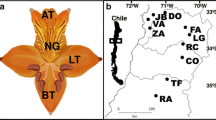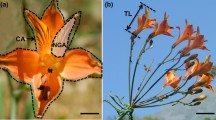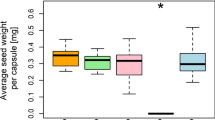Abstract
The Neotropical group of Ericaceae offers a variety of floral displays. Here we present data on floral characteristics and breeding system of Disterigma stereophyllum, a Neotropical epiphyte Ericaceae abundant in semi-disturbed areas with pollinator unpredictability. Floral characteristics are intermediate between those typical of bee- and hummingbird-pollinated plants: the corolla is short, white, and urceolate, but the composition and amount of nectar are similar to those typically observed in hummingbird-pollinated species. Plants are capable of autonomously self-pollination, but manual outcrossing yielded more than twice as many fruits as self hand-pollination did. Moreover, outcross pollen grows more rapidly than self pollen down the style. Our results provide another example of a species with a ``mixed pollination syndrome'' which is cryptically self-incompatible and preferably attracts high-energy pollinators (hummingbirds), but which can also profit from small bee visitors and retains the ability to self-pollinate just in case. We hypothesize that interaction among several factors, including self pollinating possibility, and the capacity to attract a wide pollinator spectrum, may result in a lack of strong selection for a bee vs. a hummingbird floral morphology, thus allowing the persistence of mixed floral traits in these ericads. The maintenance of these traits may enhance the ability of this species to colonize semi-disturbed areas.
Similar content being viewed by others
References
Aizen M. A. and Feinsinger P. (1994a). Forest fragmentation, pollination and plant reproduction in a Chaco dry forest, Argentina. Ecology 75: 330–351
Aizen M. A. and Feinsinger P. (1994b). Habitat fragmentation, native insect pollinators and feral honey bees in Argentine “Chaco Serrano”. Ecol. Appl. 4: 378–392
Armbruster W. S. (1993). Evolution of plant pollination systems: hypotheses and tests with the Neotropical vine Dalechampia. Evolution 47: 1480–1505
Armbruster W. S. (1997). Exaptations link evolution of plant-herbivore and plant-pollinator interactions: a phylogenetic inquiry. Ecology 78: 1661–1672
Armbruster W. S., di Stilio V. S., Tuxill J. D., Flores T. C. and Velasquez J. L. (1999). Covariance and decoupling of floral and vegetative traits in nine Neotropical plants: a re-evaluation of Berg's correlation-pleiades concept. Amer. J. Bot. 86: 39–55
Ashman T. L. (2000). Pollinator selectivity and its implications for the evolution of dioecy and sexual dimorphism. Evolution 81: 2577–2591
Bateman A. J. (1956). Cryptic self-incompatibility in the wallflower: Cheiranthus cheiri L. Heredity 10: 257–261
Berg R. L. (1960). The ecological significance of correlation Pleiades. Evolution 14: 171–180
Brunet J. and Eckert C. G. (1998). Effects of floral morphology and display on outcrossing in Blue Columbine, Aquilegia caerulea (Ranunculaceae). Funct. Ecol. 12: 596–606
Busby W. H. (2000). Hummingbird pollination of epiphytic ericaceae in the cloud forest canopy. In: Nadkarni, N. M. and Wheelwright, N. T. (eds) Monteverde: ecology and conservation of a tropical cloud forest, pp 267–268. Oxford University Press, Oxford
Campbell D. R. (1991). Effects of floral traits on sequential components of fitness in Ipomopsis aggregata. Amer. Naturalist 137: 713–737
Campbell D. R. (1996). Evolution of floral traits in a hermaphroditic plant: field measurements of heritabilities and genetic correlations. Evolution 50: 1442–1453
Campbell D. R., Waser N. M. and Price M. V. (1996). Mechanisms of hummingbird-mediated selection for flower width in Ipomopsis aggregata. Ecology 77: 1463–1472
Cruden R. W. and Hermann S. M. (1983). Studying nectar? Some observations on the art. In: Bentley, B. and Elias, T. S. (eds) The biology of nectaries, pp 223–241. Columbia University Press, New York
Cruden R. W. and Lloyd R .M. (1995). Embryophytes have equivalent sexual phenotypes and breeding systems: why not a common terminology to describe them. Amer. J. Bot. 82: 816–825
Dafni A. (1992). Pollination ecology. A practical approach. Oxford University Press, Oxford
Diggle P. K. (1992). Development and the evolution of plant reproductive characters. In: Wyatt, R. (eds) Ecology and evolution of plant reproduction: new approaches, pp 326–355. Chapman and Hall, New York
Eckert C. G. and Schaefer A. (1998). Does self-pollination provide reproductive assurance in wild columbine, Aquilegia canadensis (Ranunculaceae)?. Amer. J. Bot. 85: 919–924
Fenster C. B., Armbruster W. S., Wilson P., Dudash M. R. and Thomson J. D. (2004). Pollination syndromes and floral specialization. Annual Rev. Ecol. Evol. Syst. 35: 375–403
Holdridge L. (1996) Ecología basada en zonas de vida. 4ª Reimpresión. Ed. IICA/CIRA. San José, Costa Rica.
Johnson S. D. and Steiner K. E. (2000). Generalization versus specialization in plant pollination systems. Trends Ecol. Evol. 15: 190–193
Kearns C. A., Inouye D. W. and Waser N. M. (1998). Endangered mutualisms: the conservation of plant-pollinator interactions. Annual Rev. Ecol. Syst. 29: 83–112
Kraemer M. (2001). On the pollination of Bejaria resinosa Mutis ex Linné f. (Ericaceae), an ornithophilous Andean páramo shrub. Flora 196: 59–62
Ladley J. J., Kelly D. and Robertson A. W. (1997). Explosive flowering, nectar production, breeding systems, and pollinators of New Zealand mistletoes (Loranthaceae). New Zealand J. Bot. 35: 345–360
Lange R. S., Scobell S. A. and Scott P. E. (2000). Hummingbird-syndrome traits, breeding system, and pollinator effectiveness in two syntopic Penstemon species. Int. J. Pl. Sci. 161: 253–263
Lange R. S. and Scott P. E. (1999). Hummingbird and bee pollination of Penstemon pseudospectabilis. J. Torrey Bot. Soc. 162: 99–106
Luteyn J. L. (1989). Speciation and diversity of Ericaceae in Neotropical montane vegetation. In: Holm-Nielsen, L. B., Nielsen, I. C. and Balslev, H. (eds) Tropical forest: Botanical dynamics, speciation and diversity, pp 297–310. Academic Press, London
Luteyn J. L. and Silva D. S. (1999). ``Murri'' (Antioquia Department, Colombia): hotspot for Neotropical blueberries (Ericaceae: Vaccinieae). Brittonia 51: 280–302
Lloyd D. G. and Schoen D. J. (1992). Self- and cross-fertilization in plants. I. Functional dimensions. Int. J. Pl. Sci. 153: 358–369
Martin F. W. (1959). Staining and observing pollen tubes in the style by means of fluorescence. Stain Technol. 34: 125–128
Melampy M. N. (1987). Flowering phenology, pollen flow and fruit production in the Andean shrub Befaria resinosa. Oecologia 73: 293–300
Meléndez-Ackerman E., Campbell D. R. and Waser N. M. (1997). Hummingbird behavior and mechanisms of selection on flower color in Ipomopsis. Ecology 78: 2532–2541
Murcia C. and Feinsinger P. (1996). Interspecific pollen loss by hummingbirds visiting flower mixtures: effects of floral architecture. Ecology 77: 550–560
Murray K. G., Feinsinger P., Busby W. H., Linhart Y. B., Beach J. H. and Kinsman S. (1987). Evaluations of character displacement among plants in two tropical pollination guilds. Ecology 68: 1283–1293
Navarro L. (1999). Pollination ecology and effect of nectar removal in Macleania bullata (Ericaceae). Biotropica 31: 618–625
Navarro L. (2001). Reproductive biology and effect of nectar robbing on fruit production in Macleania bullata (Ericaceae). Pl. Ecol. 152: 59–65
Ollerton J. (1998). Sunbird surprise for syndromes. Nature 394: 726–727
Orejuela J. E. (1987). La reserva natural La Planada y la biogeografía andina. Humboldtia 1: 117–148
Ornduff R. (1969). Reproductive biology in relation to systematics. Taxon 18: 121–133
Restrepo C. and Gómez N. (1998). Responses of understory birds to anthropogenic edges in a Neotropical montane forest. Ecol. Applic. 81: 170–183
Schemske D. W. and Bradshaw H. D. (1999). Pollinator preference and the evolution of floral traits in monkeyflowers (Mimulus). Proc. Natl. Acad. Sci. USA 96: 11910–11915
Systat (1997) Statistics, version 7. Evanston, IL.
Thomson J. D., Wilson P., Valenzuela M. and Malzone M. (2000). Pollen presentation and pollination syndromes, whit special reference to Penstemon. Pl. Spec. Biol. 15: 11–29
Wyatt R. (1983). Pollinator-plant interactions and the evolution of breeding systems. In: Real, L. (eds) Pollination biology, pp 51–95. Academic Press, London
Author information
Authors and Affiliations
Corresponding author
Additional information
This paper is devoted to the memory of Martha Janeth Portillo.
Rights and permissions
About this article
Cite this article
Navarro, L., Ayensa, G. & Guitián, P. Adaptation of floral traits and mating system to pollinator unpredictibility: the case of Disterigma stereophyllum (Ericaceae) in southwestern Colombia. Plant Syst. Evol. 266, 165–174 (2007). https://doi.org/10.1007/s00606-007-0530-5
Received:
Accepted:
Published:
Issue Date:
DOI: https://doi.org/10.1007/s00606-007-0530-5




